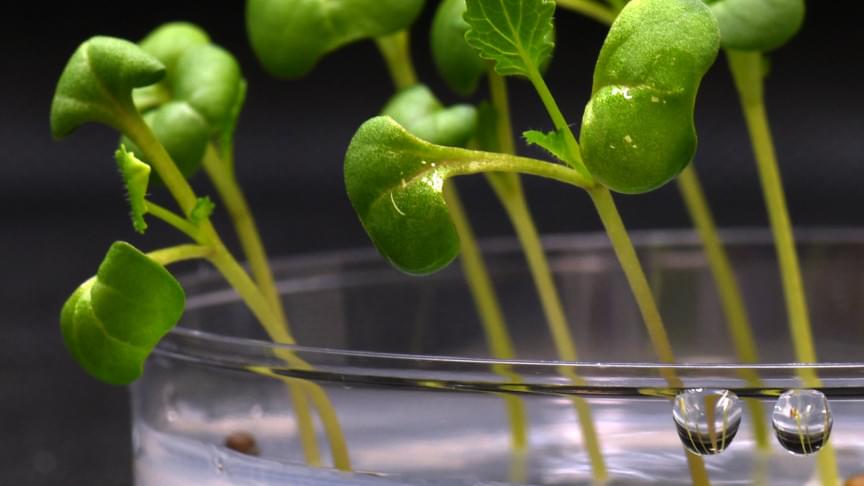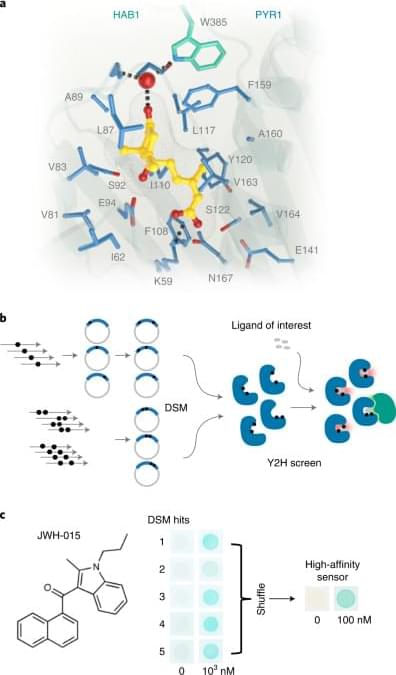View insights.
A quantum microphone can record human speech better than an equivalent classical version, and it could also be adapted for high-resolution biological imaging.

View insights.
A quantum microphone can record human speech better than an equivalent classical version, and it could also be adapted for high-resolution biological imaging.

The researchers also optimized their electrolyzer to produce the highest levels of acetate ever produced in an electrolyzer to date. What’s more, they found that crop plants, including cowpea, tomato, rice, green pea, and tobacco, all have the potential to be grown in the dark using the carbon from acetate. There’s even a possibility that acetate could improve crop yields, though more research is required.
The researchers believe that by reducing the reliance on direct sunlight, artificial photosynthesis could provide an important alternative for food growth in the coming years, as the world adapts to the worst effects of climate change — including droughts, floods, and reduced land availability. “Using artificial photosynthesis approaches to produce food could be a paradigm shift for how we feed people. By increasing the efficiency of food production, less land is needed, lessening the impact agriculture has on the environment. And for agriculture in non-traditional environments, like outer space, the increased energy efficiency could help feed more crew members with less inputs,” Jinkerson explained.

At 190 years old, Jonathan the Seychelles giant tortoise recently made news for being the “oldest living land animal in the world.” Although, anecdotal evidence like this exists that some species of turtles and other ectotherms—or ‘cold-blooded’ animals—live a long time, evidence is spotty and mostly focused on animals living in zoos or a few individuals living in the wild. Now, an international team of 114 scientists, led by Penn State and Northeastern Illinois University, reports the most comprehensive study of aging and longevity to date comprising data collected in the wild from 107 populations of 77 species of reptiles and amphibians worldwide.
Among their many findings, which they report today in the journal Science, the researchers documented for the first time that turtles, crocodilians and salamanders have particularly low aging rates and extended lifespans for their sizes. The team also found that protective phenotypes, such as the hard shells of most turtle species, contribute to slower aging, and in some cases even ‘negligible aging’—or lack of biological aging.
“Anecdotal evidence exists that some reptiles and amphibians age slowly and have long lifespans, but until now no one has actually studied this on a large scale across numerous species in the wild,” said David Miller, senior author and associate professor of wildlife population ecology, Penn State. “If we can understand what allows some animals to age more slowly, we can better understand aging in humans, and we can also inform conservation strategies for reptiles and amphibians, many of which are threatened or endangered.”

By combining two distinct approaches into an integrated workflow, Singapore University of Technology and Design (SUTD) researchers have developed a novel automated process for designing and fabricating customized soft robots. Their method, published in Advanced Materials Technologies, can be applied to other kinds of soft robots—allowing their mechanical properties to be tailored in an accessible manner.
Though robots are often depicted as stiff, metallic structures, an emerging class of pliable machines known as soft robots is rapidly gaining traction. Inspired by the flexible forms of living organisms, soft robots have wide applications in sensing, movement, object grasping and manipulation, among others. Yet, such robots are still mostly fabricated through manual casting techniques—limiting the complexity and geometries that can be achieved.
“Most fabrication approaches are predominantly manual due to a lack of standard tools,” said SUTD Assistant Professor Pablo Valdivia y Alvarado, who led the study. “But 3D printing or additive manufacturing is slowly coming into play as it facilitates repeatability and allows more complex designs—improving quality and performance.”

For the first time, researchers have demonstrated an artificial organic neuron, a nerve cell, that can be integrated with a living plant and an artificial organic synapse. Both the neuron and the synapse are made from printed organic electrochemical transistors.
On connecting to the carnivorous Venus flytrap, the electrical pulses from the artificial nerve cell can cause the plant’s leaves to close, although no fly has entered the trap. Organic semiconductors can conduct both electrons and ions, thus helping mimic the ion-based mechanism of pulse (action potential) generation in plants. In this case, the small electric pulse of less than 0.6 V can induce action potentials in the plant, which in turn causes the leaves to close.
“We chose the Venus flytrap so we could clearly show how we can steer the biological system with the artificial organic system and get them to communicate in the same language,” says Simone Fabiano, associate professor and principal investigator in organic nanoelectronics at the Laboratory of Organic Electronics, Linköping University, Campus Norrköping.

A population of photosynthetic algae has been shown to exhibit a highly nonlinear response to light, forming dynamic structures in light-intensity gradients.
Many photosynthetic microbes move in response to light. For example, the single-celled green alga Chlamydomonas reinhardtii swims toward moderate light to photosynthesize and away from intense light to avoid damage. Two longstanding questions about this light response regard how light-seeking cells move in a light-intensity gradient and whether this motion depends on cell concentration. Now, Aina Ramamonjy and colleagues at the French National Center for Scientific Research (CNRS) and the University of Paris have answered these questions [1]. The results could improve our understanding of how groups of photosynthetic organisms arrange themselves into dynamic patterns to control the amount of light that they receive.
In 1911, the botanist Harold Wager reported a seminal study [2] that launched the field of bioconvection, a collective phenomenon that results in self-organized structures and emergent flow patterns in suspensions of swimming microbes. The overall picture is that dense collections of microbes that are heavier than surrounding water but can swim against gravity self-organize into passively descending, cell-packed plumes flanked by actively ascending, cell-sparse populations.
Tricarboxylic acid cycle/kreb cycle/citric acid cycle.
#citricacidcycle #krebs #biochemistry #biology #Cellular #respiration
This Video Explains Tricarboxylic Acid Cycle/Kreb Cycle/Citric Acid Cycle.
Thank You For Watching.
Please Like And Subscribe to Our Channel: https://www.youtube.com/EasyPeasyLearning.
Like Our Facebook Page: https://www.facebook.com/learningeasypeasy/
Join Our Facebook Group: https://www.facebook.com/groups/460057834950033
Support Our Channel: https://www.patreon.com/supereasypeasy

Synopsis: The arrival of homo sapiens on Earth amounted to a singularity for its ecosystems, a transition that dramatically changed the distribution and interaction of living species within a relatively short amount of time. Such transitions are not unprecedented during the evolution of life, but machine intelligence represents a new phenomenon: for the first time, there are agents on earth that are not part of the biosphere. Instead of competing for a niche in the ecosystems of living systems, AI might compete with life itself.
How can we understand agency in the context of the cooperation and competition between AI, humans and other organisms?
This talk was part of the ‘Stepping Into the Future‘conference.
Bio: Joscha Bach, Ph.D. is an AI researcher who worked and published about cognitive architectures, mental representation, emotion, social modeling, and multi-agent systems. He earned his Ph.D. in cognitive science from the University of Osnabrück, Germany, and has built computational models of motivated decision making, perception, categorization, and concept-formation. He is especially interested in the philosophy of AI and in the augmentation of the human mind.
Joscha has taught computer science, AI, and cognitive science at the Humboldt-University of Berlin and the Institute for Cognitive Science at Osnabrück.
His book “Principles of Synthetic Intelligence – PSI: An Architecture of Motivated Cognition” (Oxford University Press) is available on amazon.

As artificial intelligence and deep learning techniques become increasingly advanced, engineers will need to create hardware that can run their computations both reliably and efficiently. Neuromorphic computing hardware, which is inspired by the structure and biology of the human brain, could be particularly promising for supporting the operation of sophisticated deep neural networks (DNNs).
Researchers at Graz University of Technology and Intel have recently demonstrated the huge potential of neuromorphic computing hardware for running DNNs in an experimental setting. Their paper, published in Nature Machine Intelligence and funded by the Human Brain Project (HBP), shows that neuromorphic computing hardware could run large DNNs 4 to 16 times more efficiently than conventional (i.e., non-brain inspired) computing hardware.
“We have shown that a large class of DNNs, those that process temporally extended inputs such as for example sentences, can be implemented substantially more energy-efficiently if one solves the same problems on neuromorphic hardware with brain-inspired neurons and neural network architectures,” Wolfgang Maass, one of the researchers who carried out the study, told TechXplore. “Furthermore, the DNNs that we considered are critical for higher level cognitive function, such as finding relations between sentences in a story and answering questions about its content.”